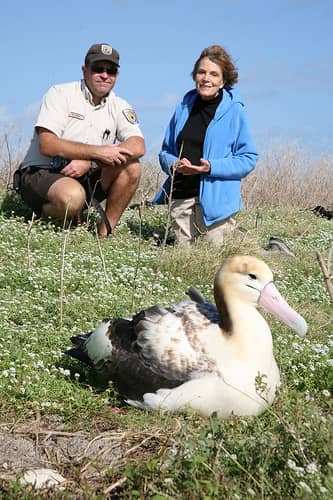Second Short-Tailed Albatross Hatches at Midway Atoll National Wildlife Refuge
OutdoorHub 01.18.12

Within hours of a recent visit by visionary oceanographer Dr. Sylvia Earle and marine wildlife artist Wyland, the second-ever hatching of a short-tailed albatross chick occurred at Midway National Wildlife Refuge within the Papahānaumokuākea Marine National Monument. The chick hatched the morning of January 12 at a nest site that Earle and Wyland visited the day before their pre-dawn departure.
Earlier in the week, Dr. Earle, describing the abundance of recovered endangered species and habitats, referred to Midway Atoll as having “hope spots” and being a “model for the world.” This particular “hope spot” now provides encouragement for the continued recovery of this endangered species and brings increased hope for other species, including ourselves.
Earle and Wyland had joined employees from the U.S. Fish and Wildlife Service, NOAA, State of Hawai‘i, and U.S. Forest Service to learn and educate others through art and science about the natural resources and restoration successes at Midway Atoll.
This is only the second hatching in recorded history of a short-tailed albatross any place other than two small islands in Japan. The chick’s parents first met four years ago; the female was 5 years-old and the male 21. They first nested last year only a few yards away from this year’s nest, amazing the scientific community by successfully raising and fledging a chick despite two major storms and the March 11, 2011, Japanese tsunami that washed the young bird more than 30 meters from its nest site.
The refuge staff was thrilled when the pair reunited on Midway Atoll in early November 2011 and the female laid an egg. If all goes well, the two albatross parents will spend the next five months finding and bringing food to their chick every one to three days. They will log tens of thousands of miles, soaring between Midway and the nutrient-rich waters some 1,000 miles to the northwest, foraging on squid and flying fish eggs they will regurgitate to the chick once back at the Refuge.
Midway Atoll Refuge Manager Sue Schulmeister said of this year’s hatching, “We are excited and guardedly optimistic that this chick will grow strong and healthy enough to fledge.” Like chicks in any albatross colony, the young bird will depend on both parents to find and bring back an adequate supply of food for its growth and survival. Unfortunately, an ever increasing amount of plastic debris is mixed with albatross food sources in the ocean. When the debris is inadvertently swallowed by the adults and later fed to chicks, it can cause death to the chicks through dehydration.
Other threats to the chick’s survival include heat stress and winter storms.
“The short-tailed albatross chick raised last year thrived and fledged so we know it has good, experienced parents,” Schulmeister said. “Adequate food and weather permitting, this chick will fledge and join its sibling at sea.”
The chick will be monitored by Fish and Wildlife Service staff via remote camera.
Once one of the most abundant albatross species in the North Pacific, short-tailed albatross were hunted for feathers and by 1949 were thought to be extinct. A few birds were seen nesting on the Japanese Island of Torishima in the early 1950s and protection soon followed. Primarily due to international treaties and the work of Japanese researchers, the short-tailed albatross population is beginning to recover. By next summer, the chick at Midway will hopefully grow strong and skilled enough to leave the island, bringing increased hope for the species and the health of our planet, something that Dr. Earle certainly would have wished for.

